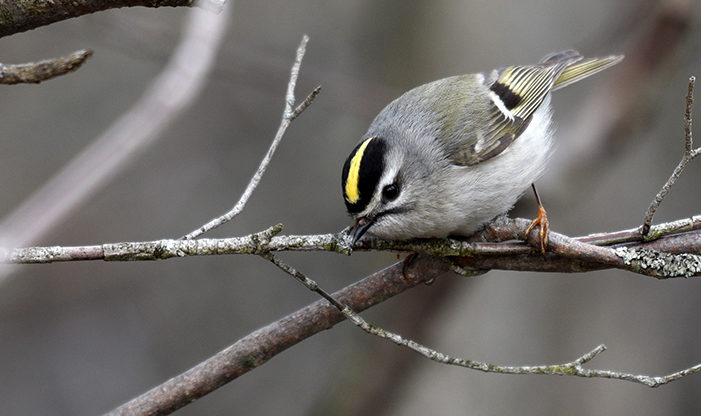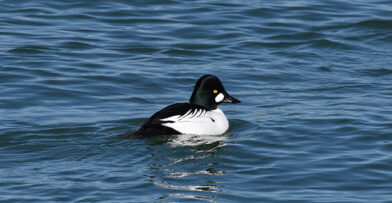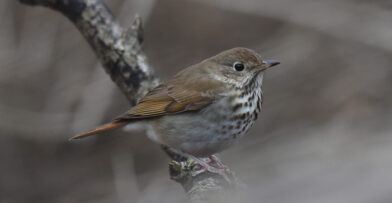Our Bird Profile series highlights a species that is migrating through, breeding, or is a year-round resident of Wisconsin that can be found at Schlitz Audubon or in your backyard.
Name
Golden-crowned Kinglet, Regulus satrapa
Basic Description & Appearance
Golden-crowned Kinglets are songbirds in the reguladae family. A tiny songbird, the Golden-crowned Kinglet gets its name from the yellow-golden crest on its head that can be a bit golden-orange on some individuals. Their backs are an olive-gray, their chest pale. They have light yellow in their wings and tail feathers with a white patch on their wings, and a distinct dark eyeline. A small but pointy beak is perfect for gleaning insects. Their range extends throughout the US, but during spring migration large numbers migrate through to their northern breeding grounds.
Song
The Golden-crowned Kinglet has a high-pitched ascending whistle-like song that occasionally ends in a warble. Their calls are also a high-pitched “tsee” note, usually two or three at a time.
Habitat & Nesting
In migration, Golden-crown Kinglets can be found in a variety of habitats including shrubby, deciduous and coniferous areas and even backyards.
Their breeding grounds are typically in coniferous forests in Canada, but their range has been extending into the northern US as well. They place their nests high in spruce or fir trees and can have two broods each nesting season. As soon as the first brood fledges, the female will begin work on a second nest while the male will continue to look after the first nestlings.
Diet & Foraging
The diet of Golden-crowned Kinglets mainly consists of insects which they acquire through gleaning, plucking from the ground, foliage, rock crevices, or even live animals. In winter they can switch to seeds.
When & Where to Find at Schlitz Audubon
While Golden-crowned Kinglet can be seen nearly everywhere at the Center during migration, they can also be found here throughout the year. Because of their tiny size and their quick nature—they hardly ever stay still—they can be hard to spot. Look high in trees for their quick fluttering, and the flash of their golden crown. They are an early migrant at Schlitz Audubon, with large numbers coming through in March and April, heading further north to their breeding grounds. On the path to Mystery Lake from the east, you are sure to find groups of kinglets singing their sweet songs in early spring. The Green Tree Loop is another great place to search, as well as climbing the tower to get an up-close view. In fall, listen for their high-pitched call along the path to the Great Hall, and you may just find some foraging in a tamarack. They can be found year-round in Milwaukee and are usually a standard find for the Christmas Bird Count in December.
Other Fun Facts
- The Golden-crowned Kinglet is barely larger than the Ruby-throated Hummingbird!
- Tiny, but hardy, they can withstand the extreme cold down to -40 Fahrenheit and will huddle with other kinglets for warmth in such conditions.


